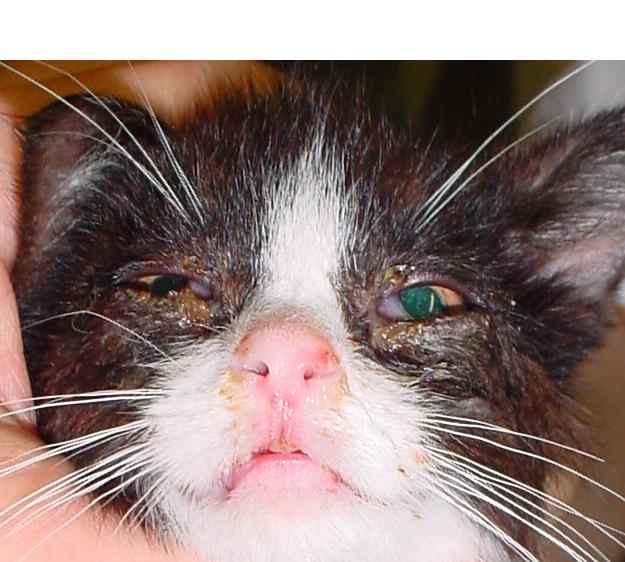
Rhinotracheitis in cats: causes, symptoms and treatment
Contents
Causes of development of rhinotracheitis and ways of infection
The main source of infection are sick cats, even those that have been ill with feline herpes for a long time. This is because, once infected, the animal remains a carrier of Feline herpesvirus forever.
Infection can occur when communicating with a sick cat and by airborne droplets, as well as in utero – from mother to kittens. In addition, the feline rhinotracheitis virus is quite tenacious and dangerous for 24 hours, so cat owners can become its carriers. After interacting with a supposedly sick animal, hands, clothes and shoes should be carefully treated – the Feline herpesvirus virus is destroyed by strong acids, alkali, and also at temperatures above 56 ° C.
Symptoms of rhinotracheitis
After infection with rhinotracheitis, an incubation period begins, when the disease does not manifest itself in any way. Usually this period lasts about 10 days.
The first symptoms of rhinotracheitis in cats:
- redness on the mucous membranes of the respiratory tract,
- nose run,
- sneezing and coughing,
- copious discharge from the eyes,
- swelling of the eyelids, inflammation of the eyes,
- photophobia,
- salivation.
The following are more obvious signs:
- apathy and lethargy
- shortness of breath,
- temperature above 39 °C,
- lack of appetite,
- clouding of the cornea,
- constipation,
- exhaustion,
- problems with coordination
- disorders of the central nervous system.
There are two types of feline herpes: acute and chronic. Acute rhinotracheitis most often lasts from one to two weeks, after which complete recovery occurs. The chronic form of the disease can last up to two months with periods of remission and exacerbation. Rhinotracheitis is especially dangerous for kittens and cats that have undergone surgery or serious illness shortly before infection.
Diagnosis and treatment of rhinotracheitis in cats
At the first signs of the disease, you should contact your veterinarian to diagnose the virus as soon as possible and start fighting the infection. The basis for the diagnosis of rhinotracheitis is laboratory analysis, since the symptoms of feline herpes are nonspecific. For analysis, a swab is taken from the mucous membranes of the nose and throat.
After the diagnosis, the veterinarian will prescribe therapy, which may include an antiviral drug, broad-spectrum antibiotics, as well as drugs to increase the animal’s immunity. In especially severe cases, the pet may be placed in a hospital.
Even after recovery, cats remain carriers of the herpes virus and can get sick again. The catalyst for secondary rhinotracheitis can be:
- stress,
- other infectious diseases
- taking corticosteroids,
- pregnancy in cats.
Measures to prevent rhinotracheitis
To reduce the chance of your pet getting infected, follow some simple hygiene rules:
- hide street clothes and shoes in places inaccessible to pets;
- wash hands with soap after returning home from the street;
- periodically disinfect cat trays, bowls and toys;
- maintain hygiene of the cat’s nostrils and eyes.
In addition, it is important to monitor the general condition of the animal, vaccinate on time and prevent free range. Proper nutrition and strong immunity are the key to good pet health.
See also:
- Is the kitten healthy?
- How to support the immune system of a cat
- The cat is choking: what to do





